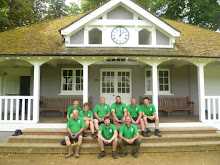 |
| Lavendar Nesting Site |
An unusual event occurred today on the balcony of the student room A10 of the Sainsbury Building, not the fact that a clutch of duck eggs hatched but the unusual location! Charlotte had noticed a female mallard visiting and sitting in the lavendar for the last month, the reason was discovered this morning when she was awoken by lots of quacking, 9 ducklings appeared with the mallard on the balcony.
 |
| Mallard And Her 9 Ducklings |
Wary at first the ducklings remained close to their mothers side until a large tray was brought up to the balcony and filled with water for them to drink, however their instinct was not to drink it but to go straight to the water and swim in it.
 |
| Time For A Swim |
 |
| Balcony Up High |
As the day progressed this instinct to be on water become stronger resulting in the mother flying down from the balcony and calling to her brood to follow. Only 8-12 hours old, and unable to fly like their mother, they had to jump!
 |
| Catch! |
 |
| Catch! |
Being encouraged by their mother, quacking to them from the ground below, the first duckling looked over the edge of the balcony and jumped, landing with a bump on the floor. Getting up unscathed, the landing had been softened by its down feathers, it waddled over to its mother's side. However, the duckling may not have felt anything, but it was all too much to bear for students Tom and Julia who decided to help the 8 remaining ducklings, catching each one of them in a box as they jumped and fell from the extrodinary height for such a small, young bird.
 |
| The Group Waits For Their Mother |
Gathering them up, the mother duck lead her brood along to the water's edge and jumped in. More encouragement followed, quacking at the youngsters to jump one last time.
 |
| This Way |
 |
| One Last Jump |
Looking over the edge they trusted their mother once again and jumped in to the water. Gathering them up she lead them away from the helping humans and out on to the water. (A sad note, the mother unfortunately miscounted her brood and only took 8 ducklings to the lake, leaving 1 behind up on the balcony which would not come out from beneath the lavander planter, its fate is unknown).
 |
| On The Lake At Last |
Footnote 'It's A Happy Ending After All'
An Email From Tom, One Of The Student Duck Rescuers:
After the mother had taken the other 8 down to the lake,
Julia and I went to try and coax out the 9th,
and it eventually managed to find a way out from behind the lavender
and jumped, so we managed to scoop him up into a box and carry him down
to the lake. We found the rest of the brood with the mother on the
lake’s edge, and thankfully the moment we tipped
him out of the box and he went onto the lake, the mother came over to
collect him and swam off with all 9 ducklings.
















































